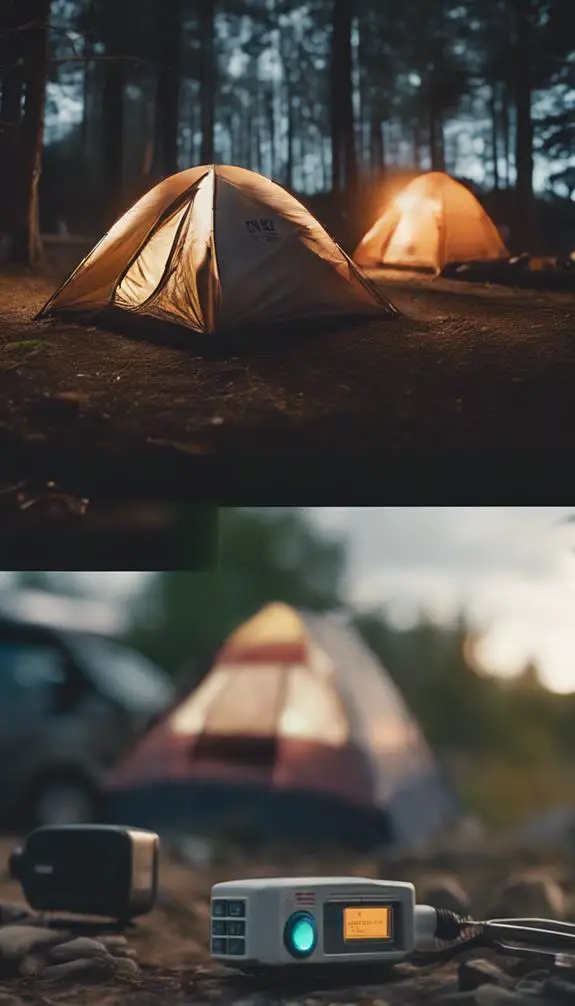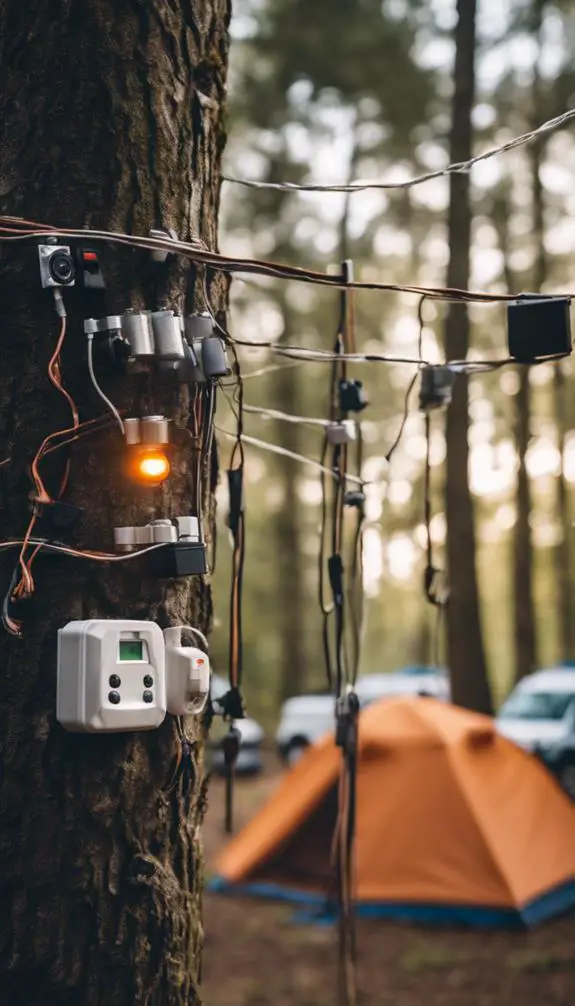As you prepare to set up a perimeter alarm to safeguard your camp, you're taking a vital step in protecting yourself and your gear from potential threats. But before you start installing sensors and cameras, take a step back to assess your campsite's unique security needs. Walk the perimeter to identify entry and exit points, noting any obstacles that could impact sensor performance. What you discover will lay the foundation for a tailored security system that effectively detects genuine threats. Now, it's time to dig deeper into the specifics of designing a reliable perimeter alarm – starting with choosing the right alarm trigger methods.
Summary
- Assess the campsite's terrain, size, and vulnerabilities to determine the level of security needed and potential entry points.
- Choose a reliable alarm system with weather-resistant, tamper-proof sensors and a stable power source that suits the camp's specific needs.
- Strategically place sensors to detect potential threats, adjusting sensitivity levels and detection ranges to minimize false alarms and maximize detection.
- Integrate the alarm system with cameras and motion detectors to create a comprehensive security network, and test the system to ensure it functions as intended.
- Regularly inspect and maintain the alarm system, updating software and firmware, to ensure continuous operation and optimal performance.
Choosing the Right Perimeter Alarm

When selecting a perimeter alarm, you must consider the specific requirements of your property and the level of security you need to achieve.
You'll want to assess the size of your campsite, the type of terrain, and the potential vulnerabilities. Wireless options are ideal for remote areas or temporary setups, offering flexibility and ease of installation.
Research reputable sensor brands, such as Dakota Alert or Guardline, that offer reliable and durable products. Consider the type of sensors you need, such as infrared, magnetic, or seismic, and the range of detection required.
Guarantee the alarm system is weather-resistant, tamper-proof, and has a reliable power source. By carefully evaluating your needs, you can choose a perimeter alarm that provides effective security and peace of mind.
Assessing Your Campsite's Terrain

Your chosen perimeter alarm system will only be effective if you've accurately assessed your campsite's terrain.
Take note of the natural terrain features that could impact your alarm's performance, such as hills, valleys, and bodies of water. Identify camp obstacles like trees, rocks, and bushes that could block or disrupt the signal.
Consider the direction of sunlight and wind, as these can affect sensor sensitivity.
Walk the perimeter of your campsite to identify potential entry and exit points, and note any areas where an intruder might try to breach your perimeter.
Selecting Alarm Trigger Methods

Settle on the most effective trigger method for your perimeter alarm by evaluating the types of intrusions you want to detect.
You'll need to decide between wireless triggers, which offer greater flexibility and ease of installation, or wired triggers, which provide a more stable connection.
Motion sensitivity is another vital factor to weigh.
Will you opt for passive infrared (PIR) sensors, which detect heat and motion, or dual-tech sensors, which combine PIR and microwave technology for increased accuracy?
You may also want to weigh triggers that detect vibrations, pressure, or magnetic fields.
Whatever method you choose, tailor it to your campsite's unique environment and the types of intruders you're trying to detect.
Deciding on Alarm Response Types

Vigilance is key when it comes to responding to potential threats, and your perimeter alarm's response type plays a critical role in this regard.
You'll need to decide on the type of response that suits your camp's security needs. Your alarm preferences will dictate how the system reacts to triggered sensors.
Will it sound a loud siren, send alerts to your phone, or trigger a strobe light? You'll also need ponder the risk of false alarms, which can be costly and lead to complacency.
A well-configured response type will minimize false alarms while ensuring you're alerted to genuine threats. Take the time to weigh your options carefully, as your response type will be the first line of defense in protecting your camp.
Setting Up Alarm Sensors Properly

Positioning alarm sensors strategically around your camp's perimeter is essential to detecting potential threats effectively.
You'll want to focus on sensor placement, ensuring they're installed in areas where they'll detect potential intruders without generating false alarms. Consider the terrain, vegetation, and weather conditions that may impact sensor performance.
Alarm customization is also pivotal, as you'll need to adjust sensitivity levels and detection ranges to suit your specific needs. Take the time to fine-tune your sensors, and you'll be rewarded with a reliable and effective perimeter alarm.
Properly configured sensors will provide you with the early warning you need to respond to potential threats and protect your camp.
Positioning Sensors for Optimal Coverage

When positioning sensors for maximum coverage, you'll need to develop a sensor placement strategy that takes into account the unique layout of your perimeter.
This involves carefully considering corner and edge coverage to minimize blind spots, where intruders could potentially go undetected.
Sensor Placement Strategy
As you plan your perimeter alarm system, strategically placing sensors becomes crucial to achieving ideal coverage.
To maximize sensor effectiveness, you'll want to employ a Sensor Optimization strategy. This involves identifying high-risk areas, such as gates, doors, and vulnerable sections of your camp's perimeter.
By clustering sensors in these areas, you'll create a dense network of detection points, ensuring that any potential threats are quickly identified. This Sensor Clustering approach enables you to allocate resources efficiently, while maintaining a strong defense against intruders.
Corner and Edge Coverage
Your camp's perimeter corners and edges are particularly vulnerable to intruder breaches, making targeted sensor placement in these areas crucial for ideal coverage.
To guarantee thorough protection, you'll want to focus on corner and edge detection. Corner beams, which emit infrared beams at a 90-degree angle, are ideal for detecting intruders attempting to breach your camp's corners.
For edge detection, you'll want to place sensors along the perimeter's edges, certifying that any attempted breaches are quickly identified. By positioning sensors in these high-risk areas, you'll substantially reduce the likelihood of undetected intrusions.
Remember to adjust sensor sensitivity and range to accommodate your camp's unique terrain and environmental conditions.
Blind Spot Identification
Having secured your camp's corners and edges, you're now ready to identify potential blind spots that could compromise your perimeter alarm's effectiveness.
Conduct a thorough vulnerability analysis to pinpoint areas where your sensors may not provide adequate coverage. Look for security gaps around obstacles like trees, buildings, or terrain features that could conceal an intruder's approach.
Consider the sensor's range, angle, and sensitivity to determine where additional units may be needed. Walk the perimeter to identify potential hiding spots and visualize how an intruder might exploit them.
Connecting Sensors to the Alarm Hub

The alarm hub, the central nervous system of your perimeter alarm, relies on sensors to detect potential breaches.
You'll need to connect these sensors to the hub to guarantee seamless communication. Start by calibrating each sensor according to the manufacturer's instructions to certify accurate detection.
Next, plan your wire management strategy to minimize clutter and reduce the risk of wire damage. Run wires from each sensor to the hub, securing them with cable ties or zip locks as needed.
Make sure to label each wire to avoid confusion during future maintenance. With your sensors connected and calibrated, you'll be one step closer to a fully functional perimeter alarm that protects your camp from unwanted intruders.
Configuring Alarm Settings and Zones

With sensors connected and calibrated, you're ready to fine-tune your perimeter alarm's settings and zones to guarantee it responds accurately to potential threats.
You'll need to configure Alarm Modes, which determine how the system responds to sensor triggers. Choose from modes like Arm, Disarm, and Test to customize your alarm's behavior.
Next, prioritize zones based on their level of importance. Zone Prioritization allows you to focus on high-risk areas, such as the camp's perimeter or storage facilities.
Assign higher priority zones to receive immediate notifications and alerts. This certifies you respond quickly to potential breaches in critical areas. By configuring Alarm Modes and Zone Prioritization, you'll create a tailored security system that responds effectively to threats and gives you peace of mind.
Integrating Additional Security Features

You've tailored your perimeter alarm's settings and zones to respond accurately to potential threats; now it's time to bolster your security system by integrating additional features that enhance its capabilities and provide an extra layer of protection.
Consider smart integration with other security devices, such as cameras and motion detectors, to create an exhaustive security network. Wireless connectivity enables seamless communication between devices, ensuring real-time alerts and notifications.
Integrate door and window sensors to detect breaches, and use smart lighting to deter intruders. Additionally, consider integrating environmental sensors to monitor temperature, humidity, and weather conditions, providing an all-encompassing security solution for your camp.
Testing the Perimeter Alarm System

Beyond initial setup, testing the perimeter alarm system is crucial to guarantee it functions as intended and provides reliable protection for your camp.
You'll want to verify that each component is operational and that the system responds correctly to potential threats. Begin by conducting a visual inspection of the perimeter, ensuring all sensors and detectors are securely installed and free from obstructions.
Next, perform alarm testing to validate the system's response to simulated intrusions. This involves triggering each sensor to verify that the alarm sounds and notifications are sent correctly.
Powering Your Perimeter Alarm

You have several power source options for your perimeter alarm, including AC-powered, battery-powered, and solar-powered units.
When selecting a power source, you'll need to weigh factors such as battery life expectancy, recharging requirements, and environmental conditions.
Understanding the power requirements and limitations of your perimeter alarm system is vital to ensuring continuous operation and minimizing downtime.
Power Sources Available
When selecting a power source for your perimeter alarm, considering the available options is crucial to ensuring uninterrupted operation and peak performance.
You'll want to explore alternative sources that can provide reliable power, especially in remote areas where traditional power sources may be scarce. Solar panels are an excellent option, as they harness renewable energy and can be easily installed in areas with sufficient sunlight.
Other alternative sources include wind turbines, fuel cells, and battery-powered generators. These options can provide a consistent power supply, ensuring your perimeter alarm remains active and effective.
Battery Life Expectancy
Optimizing battery life expectancy is critical to powering your perimeter alarm effectively. You'll want to maximize the time between battery replacements to minimize downtime and certify continuous protection.
To achieve this, focus on power conservation strategies. Select batteries with high energy density and low self-discharge rates. Limit the number of sensors and adjust their sensitivity to reduce false alarms, which can drain battery power.
Implement power-saving features like sleep modes and adjust the alarm's transmission frequency. Battery longevity factors, such as operating temperature, storage conditions, and charging cycles, also impact lifespan.
Mounting and Securing Alarm Components

Mounting and securing alarm components is a critical step in setting up a perimeter alarm, as it directly impacts the system's reliability and effectiveness.
You'll need to choose the right mounting options for your components, considering factors like visibility, accessibility, and environmental conditions. For example, you might opt for pole-mounted sensors or wall-mounted keypads.
When securing your components, prioritize weatherproofing methods like waterproof housings, sealed connectors, and UV-resistant materials to guarantee your system can withstand harsh outdoor conditions.
Properly securing your components will prevent tampering, damage, and false alarms, giving you peace of mind and reliable protection for your camp.
Regular Maintenance and Updates

Your perimeter alarm system is only as reliable as its maintenance, so regular check-ups are crucial to guaranteeing it remains effective.
To avoid false alarms and system failures, schedule checks every 3-6 months to inspect cables, sensors, and control panels for signs of damage or wear.
Perform alarm auditing to identify potential vulnerabilities and optimize your system's performance. Check battery levels, clean sensors, and test alarm triggers to verify they're functioning correctly.
Update your system's software and firmware regularly to patch security vulnerabilities and stay ahead of potential threats.
FAQs
Can I Use a Perimeter Alarm With Pets or Livestock in the Camp?
You can use a perimeter alarm with pets or livestock in the camp if you opt for pet-friendly options, such as sensors with animal deterrent designs that won't trigger false alarms, ensuring your furry friends' safety while maintaining camp security.
How Do I Prevent False Alarms Caused by Strong Winds or Weather?
You adjust the alarm's sensitivity by calibrating it to your camp's specific weather conditions, and install weather sensors to detect changes, ensuring that strong winds or storms don't trigger false alarms and compromise your freedom.
Are There Any Specific Regulations for Perimeter Alarms in National Parks?
When venturing into national parks, you'll need to comply with park rules and Federal guidelines, which often prohibit perimeter alarms that emit sound or have flashing lights, so you'll want to opt for silent or vibrating alerts to avoid fines or confiscation.
Can I Integrate My Perimeter Alarm With Other Security Systems I Own?
You can seamlessly integrate your alarm system with other security systems you own, leveraging wireless integration for a thorough defense network, ensuring your freedom from security breaches and unwanted intrusions.
How Often Should I Replace the Batteries in My Perimeter Alarm Sensors?
You'll typically need to replace batteries in your perimeter alarm sensors every 2-5 years, depending on usage and environmental factors, but it's vital to check battery life regularly and perform sensor calibration to guarantee peak performance and detection accuracy.
Conclusion
You've now successfully set up a perimeter alarm to protect your camp. By selecting the right sensors, configuring the system, and integrating with cameras and motion detectors, you've created a thorough security network. Regularly test and maintain your system to guarantee it remains effective. With your perimeter alarm in place, you can focus on enjoying your camping experience, knowing your site is secure and protected from potential threats.




